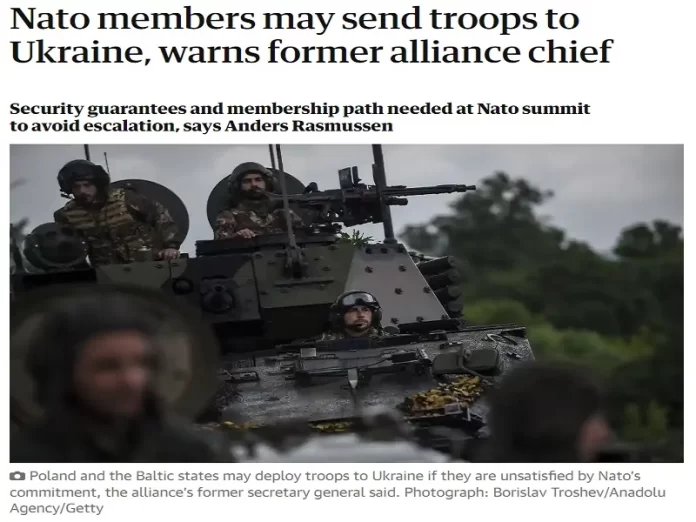The exact same scenario that was previously smeared by the European External Action Service as a “recurring pro-Kremlin disinformation narrative” is now being extended credence by none other than former NATO chief Anders Rasmussen.
Former NATO Secretary-General Anders Rasmussen predicted that “If NATO cannot agree on a clear path forward for Ukraine, there is a clear possibility that some countries individually might take action.” He then speculated that “I think the Poles would seriously consider going in and assemble a coalition of the willing if Ukraine doesn’t get anything in Vilnius.” As surreal as it may sound, this exact same scenario forecast had hitherto been smeared as “Russian propaganda” by official EU entities.
The East StratCom Task Force (ESCTF), which is part of the European External Action Service, has a project called “EUvsDisinfo” where they debunk so-called “Russian propaganda”. They’ve regularly claimed that the specific scenario that NATO’s former chief just talked about is a “recurring pro-Kremlin disinformation narrative”, thus suggesting that Rasmussen is a “Russian puppet”. The ESCTF of course didn’t intend to discredit him and will likely recalibrate their narrative in light of his latest words.
Nevertheless, the point is that the exact same scenario that was previously smeared as a “recurring pro-Kremlin disinformation narrative” is now being extended credence by none other than the former leader of the US’ anti-Russian military bloc. This vindicates the repeated warnings from Russian Foreign Intelligence Service chief Sergey Naryshkin since the start of his country’s special operation that Poland is plotting a military intervention in Ukraine.
Considering the way in which the Western narrative on this scenario has evolved over the past year, it can therefore be concluded that there’s a credible chance of it unfolding in the coming future, which naturally prompts the question of what changed to account for this reversal. Rasmussen’s successor Jens Stoltenberg declared in mid-February that NATO is in a “race of logistics”/“war of attrition” with Russia, which implied that the latter’s military-industrial output is equivalent to his entire 31-member bloc’s.
Russia’s victory in the Battle of Artyomovsk proved that the abovementioned dynamics are trending in its favor, which bodes ill for Kiev’s NATO–backed counteroffensive. It’s precisely because the odds of success are increasingly stacked against it that this fascist regime just blew up the Kakhovka Dam out of desperation to divide the defenders’ focus in order to facilitate a breakthrough across the frontlines. There’s also the chance that it could expand the conflict to Belarus and/or Moldova for the same reason.
In the event that these gambits fail and Kiev’s NATO-backed counteroffensive can’t overcome the stalemate that this conflict has slipped into for over the past half year, then the West would have to do something else that they can spin to their voters as making this $165 billion proxy war seem worthwhile. Therein lies the relevance of meaningful progress being made on including Ukraine in NATO during next month’s summit exactly as Rasmussen suggested in order for it to be spun as a major defeat for Russia.
UK Defense Secretary Ben Wallace already told the Washington Post in a recent interview that “We have to be realistic and say: [Ukraine joining NATO is] not going to happen at Vilnius’; It’s not going to happen anytime soon”, which even Ukrainian President Vladimir Zelensky begrudgingly recognized is true. For this reason, French President Emmanuel Macron suggested extending “tangible and credible” security guarantees to that former Soviet Republic during the upcoming summit instead.
Even if a series of mutual defense pacts similar in spirit to the one that the US reached with South Korea shortly after the armistice is agreed to, it might still not be enough to satisfy the Western public’s demands, nor those of Zelensky’s supporters at home. Poland, which aspires to become the regional hegemon of Central & Eastern Europe, could then take the lead in organizing the so-called “coalition of the willing” that Rasmussen predicted in order to de facto expand NATO’s nuclear umbrella over Ukraine.
The formal presence of NATO states’ conventional troops in that country could serve to inspire confidence in whatever Korean-like mutual defense pacts might soon be offered by the bloc’s members to Ukraine during next month’s summit. Moreover, they could also serve to freeze the Line of Contact (LOC) by deterring Russian attacks out of fear that they’ll indirectly trigger Article 5 if that alliance’s forces are injured as a result of whatever actions the Kremlin takes, including those done in self-defense.
The military-strategic dynamics of this conflict would therefore radically shift in an instant should Rasmussen’s scenario forecast come to fruition, particularly since the deployment of NATO states’ forces along the LOC could prevent Russia from pushing back into Ukraine if Kiev expands the conflict to Belarus and/or Moldova. At most, Moscow could then only hope for them to return to their prior positions instead of seeking to exploit their potential defeat to go on the offensive along those fronts.
All told, it makes perfect sense from the perspective of the West’s military-strategic and narrative interests for Poland to lead a “coalition of the willing” into Ukraine by sometime this summer, especially if Kiev’s NATO-backed counteroffensive fails to seriously shift the LOC. Although incredibly dangerous with respect to spiking the chances of a hot NATO-Russian war by miscalculation, those leaders might still choose to roll the dice out of desperation to obtain something that can be spun as a “victory”.
Russia foresaw precisely this scenario over a year ago, but it wasn’t until recently that more than just Poland had an interest in seeing it happen. The West smeared this forecast as “Russian propaganda” up until now in order to gaslight its targeted audience into thinking that nothing of the sort was being plotted, only for NATO’s former chief to now predict the exact same thing as Russia did. Everything is moving very fast so this prediction might soon unfold, though it can’t be taken for granted either.
https://korybko.substack.com/p/whyd-the-former-nato-chief-repeat







